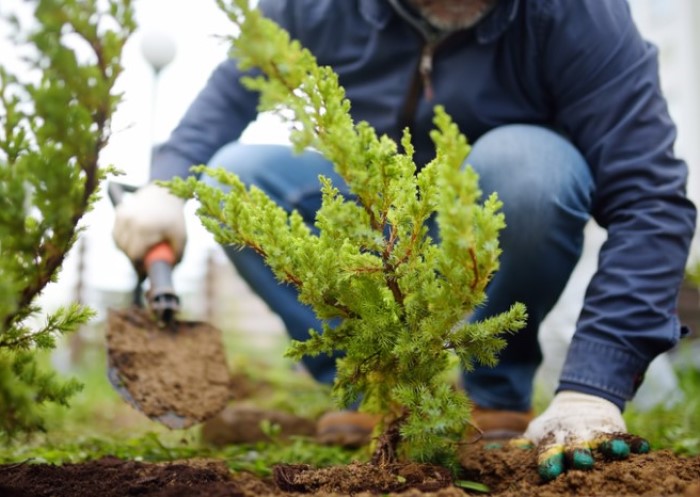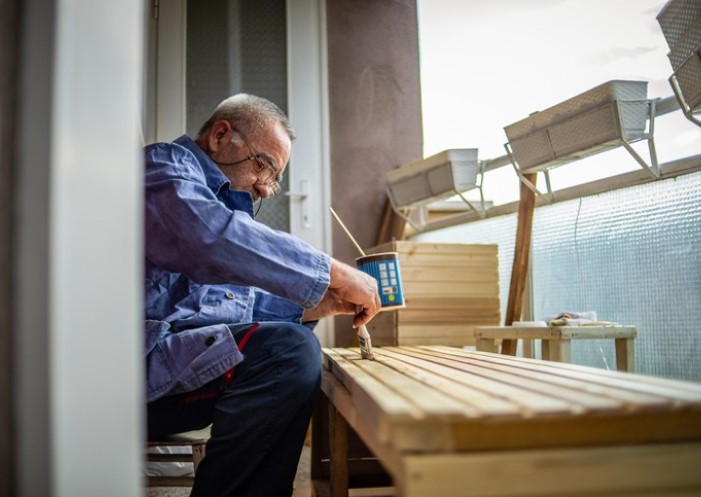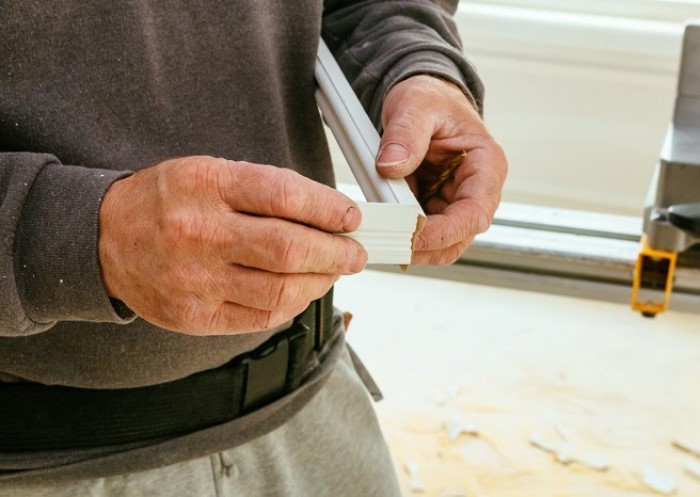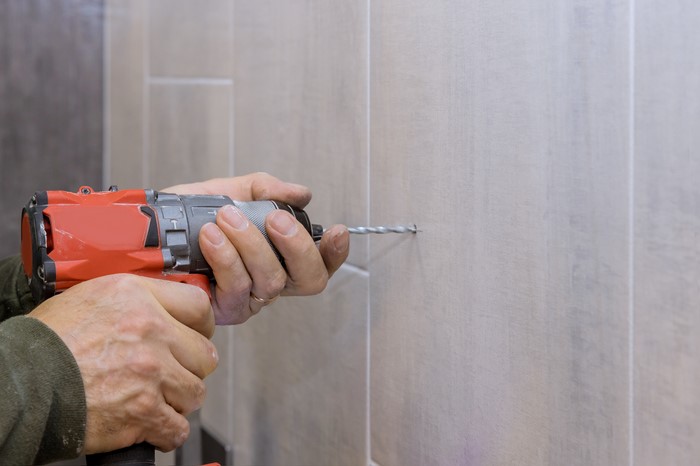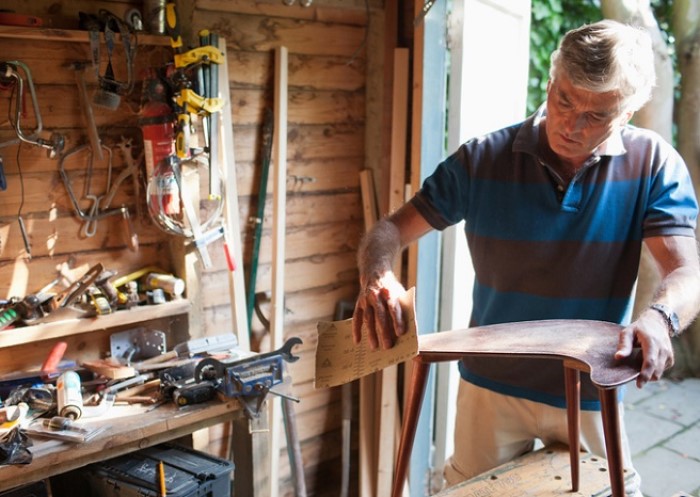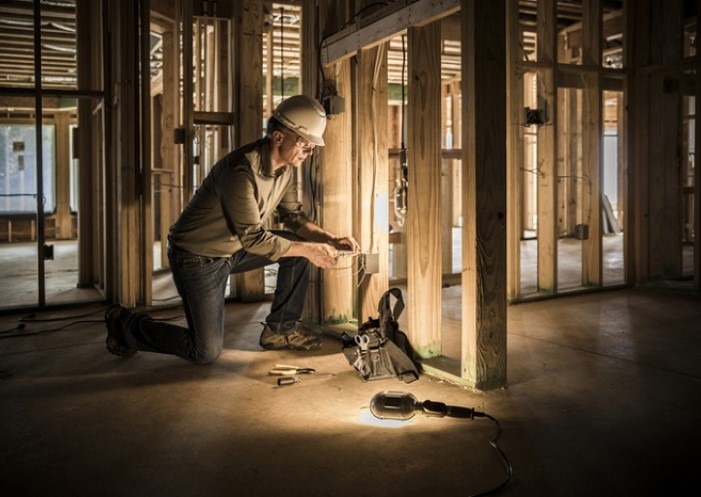Table of contents
Shrubs fulfil many functions: they provide shade and offer a habitat for birds, but above all they beautify the garden. Some shrubs can also be used as privacy screens against prying eyes. Planting shrubs at the right time is important for optimal growth and can vary depending on the type of shrub. This guide tells you how and when is best to plant which shrub, which soil conditions are necessary for shrubs to thrive in and step-by-step assistance when planting.
What conditions are important for planting bushes?
Good soil is important for optimal plant growth: it ensures that shrubs and bushes receive enough moisture and can absorb nutrients. Soil that is stony, dry or too firm makes it difficult for the shrub to thrive. Compacted soil may also promote waterlogging. Especially in very firm soils, the roots cannot spread properly – thereby inhibiting growth and preventing the bush from developing sufficiently. If the soil is very clayey, you can add a little sand to loosen up the firmness. The opposite is also true: if the soil is overly sandy and permeable, add some clay to improve its firmness. The following conditions characterise a suitable soil for planting shrubs and privacy bushes:
- the soil should be loose.
- there should be sufficient nutrients.
- the soil should be frost-free.
There are many different requirements that a plant places on its immediate environment. It is essential to take these into account so that the shrub can take root and grow into a strong, mature plant. In addition to a nutrient-rich, loose soil, it is important to choose an optimal location. Consider whether the shrub can tolerate constant, direct sunlight or prefers partial shade, and how much space it needs. Always allow enough distance from other plants, fences or buildings so that the bush is not crowded by its surroundings, and existing masonry is not damaged.
The right time: when should you plant shrubs?
You can plant many shrubs all year round, but the optimal time for planting can vary depending on how woody the plant is. The decisive factor for choosing the right time is, among other things, the condition of the roots:

Bare-root plants should be planted by March at the latest so that the roots have enough time to grow into the soil before the main growing season starts. This also applies to roses.
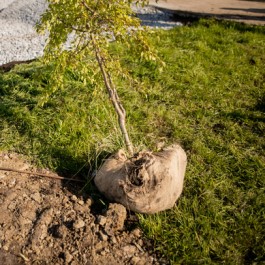
Woody plants with root balls already have a high proportion of fine roots, through which they can absorb sufficient liquid and nutrients. For this reason, you can wait to plant shrubs with root balls until the warmer months of May or June.
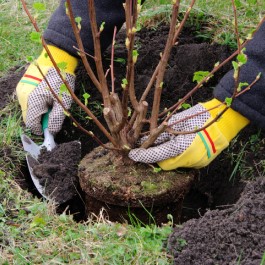
Shrubs with potted root balls can even be planted into the summer – provided you water the shrubs thoroughly during any hot and dry spells.
Planting shrubs in autumn
Autumn is also considered the optimal planting time for many shrubs. As the soil is still relatively warm at this time, the roots have enough time before frost to form fine roots that transport water and minerals. What’s more, autumn is the time when woody plants shed their leaves to focus on root growth. Thus, shrubs planted in autumn have a developmental advantage over woody plants planted in the ground in spring. Autumn as a planting time serves to prepare the woody plants for the next season.
When planting shrubs in autumn, make sure to dig the planting hole sufficiently large: the planting hole should be about one and a half to two times as wide and as deep as the root ball of the shrub. Loosen the surrounding soil generously – this facilitates the supply of water, minerals and trace elements.
Planting shrubs in spring
For some shrubs, spring is also a good time to plant – especially for plants that need some time to take root before winter. This is especially true for frost-sensitive woody plants. This gives them a whole season to take root, which means they have a better chance of surviving the winter. Early spring is also the best time for hedge trimming. In spring you can plant the following shrub species, among others:
- frost-sensitive taxa
- deciduous shrubs
- evergreen deciduous shrubs
- container plants
- shrubs with root ball
- not absolutely hardy species
If you plant shrubs in spring, make sure that they receive sufficient water. This will ensure that fine roots develop and supply the plant with sufficient minerals and trace elements. Especially in the hot summer months, it is important to water the shrubs regularly and generously.
Planting table for shrubs
An overview with examples of the planting time of different shrubs is shown in the table below.
| Time of the year | Advantages | Examples |
|---|---|---|
| Spring | • Woody plants have enough time to take root. • They survive the first winter better than if they were planted shortly before the onset of winter. | • rhododendron • hydrangea • lavender • boxwood • hibiscus • cherry laurel • bitter orange • blackberry • yew • black alder • forsythia • franklin • common juniper • common Judas tree • laburnum • buckthorn • thuja • love pearl bush • monk’s pepper • red honeysuckle • red dogwood • butterfly bush • rowan • winter jasmine |
| Autumn | • In autumn, the plants concentrate on root growth. • Woody plants have a growth spurt. | • barberry • broom • bridal and spirea shrub • common hawthorn • bristly taiga root • lilac • common pimpernut • hazelnut • raspberry • magnolia • privet • red currant • blackcurrant • gooseberry • crown vetch • grape elderberry • weeping cherry • clematis • witch hazel |
Some shrubs can be planted in spring as well as in autumn. These include mountain laurel, Chinese spicebush, daphne, rock pear, buckthorn, blackthorn and black elder.
How close to the house can bushes be planted?
Not only living space, but also gazebos, fences or pavilions can be damaged if you plant bushes too close to structures. Even pruning cannot remedy this because the damage is caused mainly by the underground root system. This is especially true for shallow-rooted plants: shallow-rooted plants can be shrubs, but some trees also fall under this category. The most common shallow-rooted shrubs include ivy, barberry, currant and gooseberry bushes and magnolia. They are characterised by their roots growing radially around the plant stem in width. Individual roots grow into the depths and anchor the plant firmly in the ground. In doing so, they can spread under structures and cause great damage.
If shallow roots spread under buildings, they can damage the building foundation: walls become cracked and floor slabs can be lifted by the roots underneath. For this reason, you should make sure to keep a sufficient distance from buildings when planting. As a rule of thumb, 2.5 metres is sufficient if you plant shallow-rooted shrubs close to the house – you should also keep this distance from neighbouring property or fences.
What are the best shrubs to use for privacy screens?
If you are looking for protection from prying eyes in the garden, you should opt for fast and dense-growing shrubs. Colourful flowering shrubs also provide a visual break in the garden. The following shrubs grow tall, fast and densely enough and are therefore ideal for use as privacy screens:
- forsythia
- jasmine
- hawthorn
- summer lilac
- dogwood
- star bush
Before planting, shrubs should be watered thoroughly. The best way to do this is to place the shrub in a bucket filled with water. After planting, you should also ensure a sufficient regular supply of water.
Planting shrubs : tips on how to proceed
It is not enough to simply dig a hole and place the shrub in it. With the following steps and the right gardening technique, you give the shrub everything it needs to grow and prosper in the garden.
- Dig a planting hole
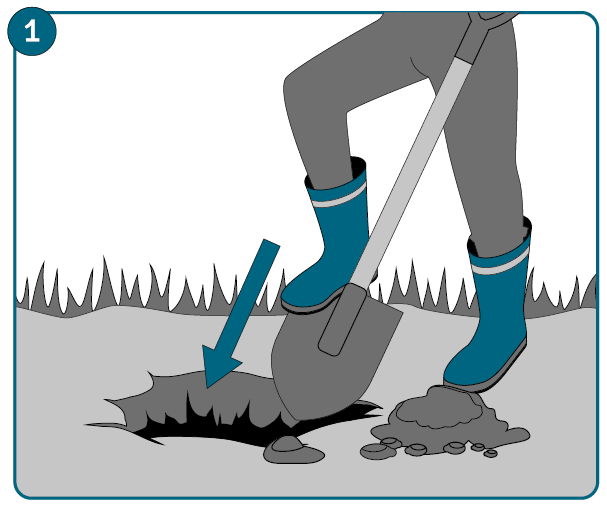 Dig a planting hole that provides enough space for root growth. As a guide, the planting hole should be about twice the size of the root ball.
Dig a planting hole that provides enough space for root growth. As a guide, the planting hole should be about twice the size of the root ball. - Loosen the soil, lay drainage
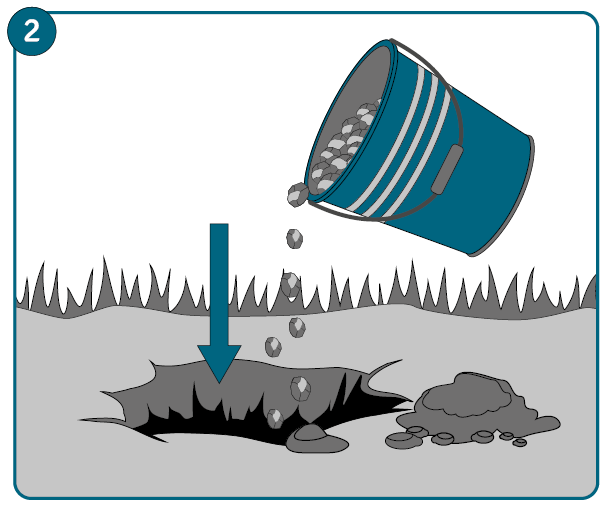 Loosen the bottom of the planting hole well with a hoe or spade. This makes it easier for the roots to grow into deeper soil layers and prevents waterlogging.
Loosen the bottom of the planting hole well with a hoe or spade. This makes it easier for the roots to grow into deeper soil layers and prevents waterlogging.
Tip: If the soil is particularly firm or clayey, layer some gravel on the bottom of the planting hole as drainage. This will make the soil more permeable to water and the roots will be well supplied. - Unpot the shrub
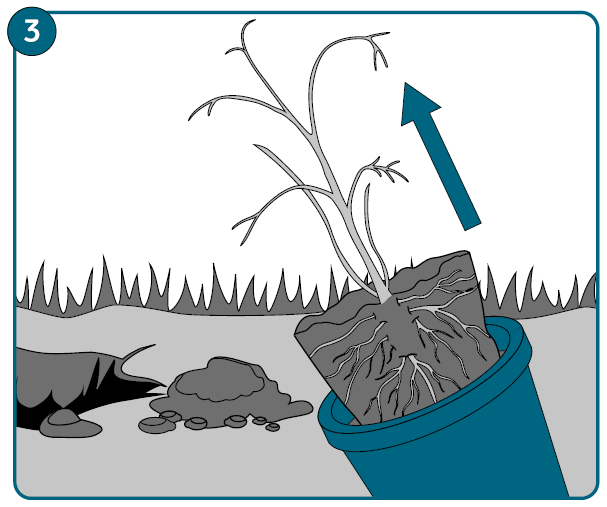 Carefully remove the root ball from the pot. Then loosen the fine hairy roots at the edge of the root ball. Be careful here, the hairy roots are equally as sensitive and important for optimal supply to the shrub. Shorten very long, strong roots with scissors.
Carefully remove the root ball from the pot. Then loosen the fine hairy roots at the edge of the root ball. Be careful here, the hairy roots are equally as sensitive and important for optimal supply to the shrub. Shorten very long, strong roots with scissors. - Place the shrub in the planting hole
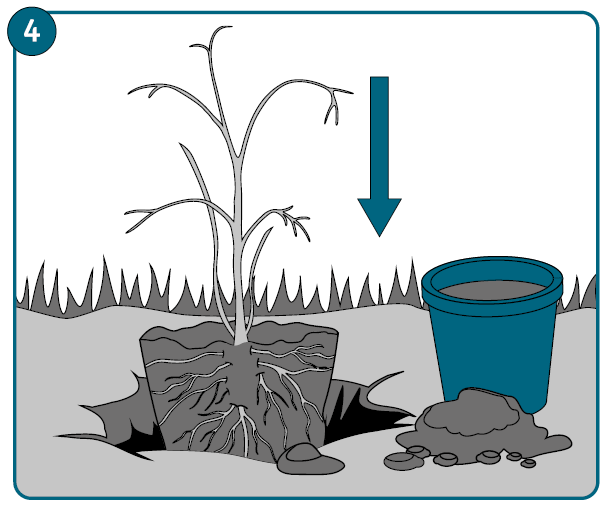 Now place the shrub in the planting hole. The root ball should not be above ground level, but below it. Make sure that the “nice” side of the plant is facing the desired direction.
Now place the shrub in the planting hole. The root ball should not be above ground level, but below it. Make sure that the “nice” side of the plant is facing the desired direction.
Particularly tall shrubs for privacy screens should be secured to a stake that you drive into the ground next to the plant to stabilise it. This will give the plant stability – especially in forceful winds. Strong movements of the plant will otherwise be passed on to the fine hair roots, which can snap off and become damaged. - Fill in the planting hole
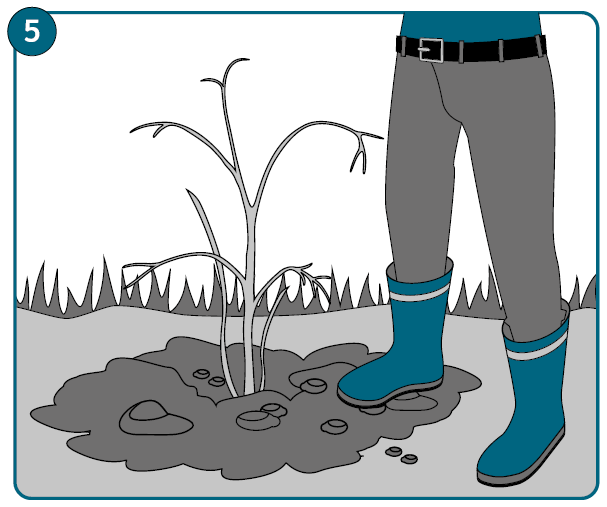 Fill the planting hole with the soil you have dug out. Add nutrient-rich humus or potting soil. Add some organic fertiliser, e.g., horn shavings to the mixture as well. Then pack the soil down around the shrub.
Fill the planting hole with the soil you have dug out. Add nutrient-rich humus or potting soil. Add some organic fertiliser, e.g., horn shavings to the mixture as well. Then pack the soil down around the shrub. - Form a watering border
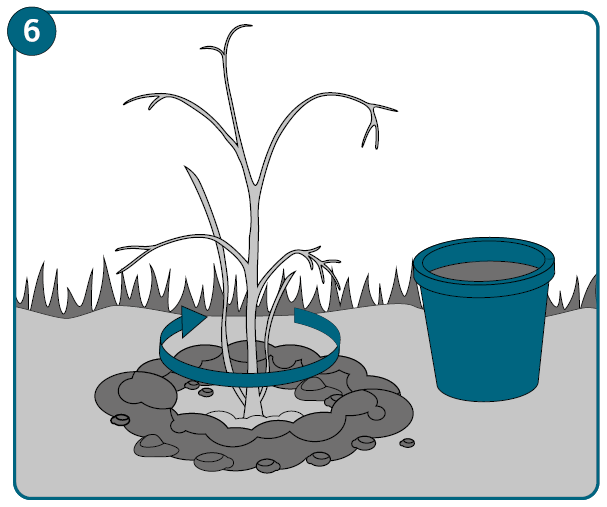 Form a small mound of soil around the shrub with your hands. This watering rim ensures that the water does not seep away sideways but can slowly penetrate the soil.
Form a small mound of soil around the shrub with your hands. This watering rim ensures that the water does not seep away sideways but can slowly penetrate the soil. - Watering the shrub
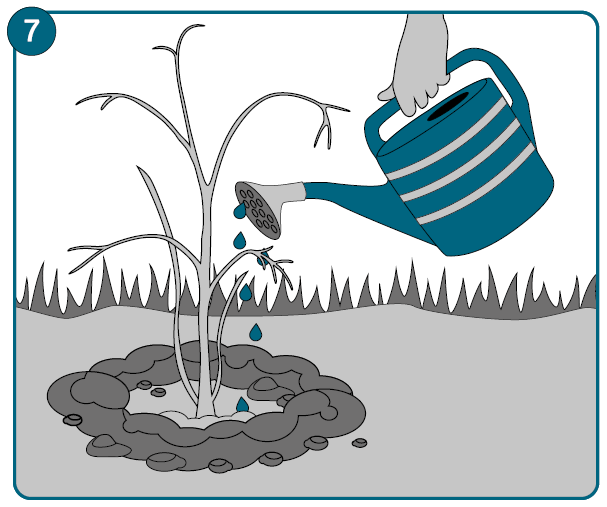 Thorough watering provides the shrub with water and nutrients immediately. It also closes cavities in the soil: This so-called soil closure ensures that new roots can form early.
Thorough watering provides the shrub with water and nutrients immediately. It also closes cavities in the soil: This so-called soil closure ensures that new roots can form early.
FAQ for planting shrubs
For many shrubs, autumn is an optimal planting time. Depending on the condition of the root system, you can also plant some shrubs in spring and even into early summer. It is better not to plant shrubs in winter when the ground is frozen.
To protect against prying eyes, it is advisable to plant dense and fast-growing shrubs. In addition, the shrubs should be able to grow to a sufficient height. The following shrubs, for example, are best for privacy screens:
• forsythia
• jasmine
• hawthorn
• summer lilac
• dogwood
• star bush
If you want to plant woody plants near buildings or fences, make sure there is sufficient distance in between, especially for shallow-rooted trees. The roots of shallow-rooted shrubs grow wide and can damage buildings. Therefore, a distance of about 2.5 metres is considered sufficient if you want to plant hedge shrubs close to your house. This also applies to the distance between the plant and fences, gazebos or a neighbouring property.
Image source:
© gettyimages.de – SbytovaMN, semen salivanchuk & LianeM

